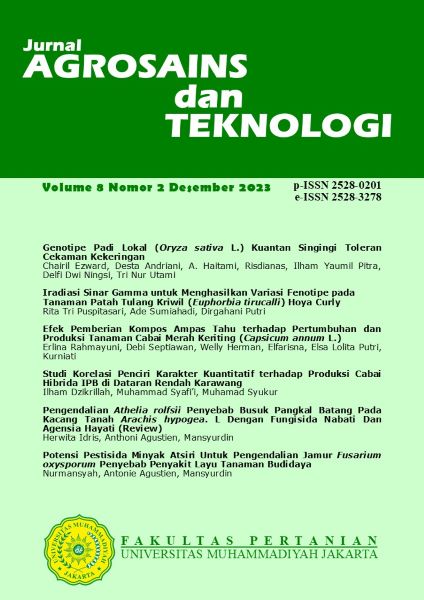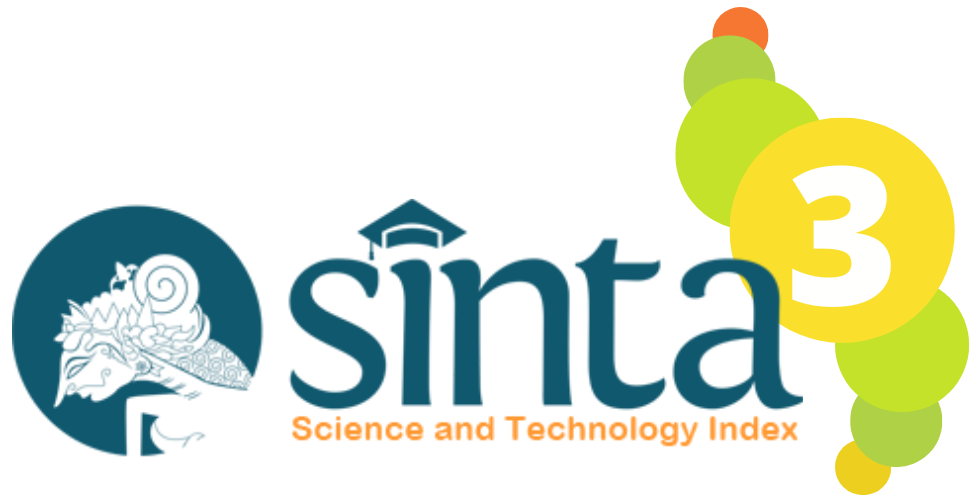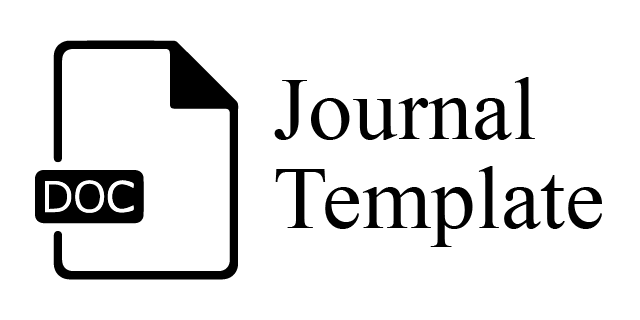Iradiasi Sinar Gamma untuk Menghasilkan Variasi Fenotipe pada Tanaman Patah Tulang Kriwil (Euphorbia tirucalli) Hoya Curly
DOI:
https://doi.org/10.24853/jat.8.2.61-68Keywords:
Fenotipe, keragaman, mutasi, pemuliaan tanamanAbstract
Indonesia memiliki biodiversitas yang tinggi, termasuk tanaman. Namun kenyataannya, Indonesia masih banyak mengimpor tanaman terutama tanaman hias dari luar negeri. Hal tersebut mendorong peneliti untuk mendapatkan jenis-jenis tanaman hias unik dan menarik yang diharapkan dapat diminati. Salah satu cara yang dilakukan adalah mutasi. Mutagen dapat berupa fisik, kimia atau rekayasa genetik. Mutagen secara fisik dengan iradiasi sinar gamma menjadi pilihan yang relatif lebih murah dan cepat dengan potensi keragaman tinggi, yang diharapkan tanaman hias menjadi lebih beragam. Tujuan penelitian ini adalah untuk mencari dosis iradiasi yang dapat mengubah fenotipe patah tulang kriwil yang berbeda dari fenotipe aslinya. Penelitian dilaksanakan di nursery Fakultas Pertanian Universitas Muhammadiyah Jakarta, pada bulan Agustus 2022 sampai November 2023. Dosis Iradiasi sinar gamma yang digunakan dalam penelitian ini adalah 0, 2, 4, 6, 8, 10, dan 12 Gy. Hasil penelitian menunjukkan bahwa dosis iradiasi sinar gamma yang digunakan pada penelitian ini belum dapat menghasilkan keragaman karakter kuantitatif maupun kualitatif pada tanaman patah tulang kriwil Hoya Curly pada pengamatan 3-6 bulan, namun setelah satu tahun kemudian baru terlihat perubahan karakter kualitatif, yaitu pada perlakuan 4 Gy dan 10 Gy. Pada dosis iradiasi 4 Gy terdapat tanaman dengan ukuran daun lebih kecil, warna daun dan batang menjadi hijau, namun bentuk daun tetap kriwil dengan habitus menjuntai seperti kontrol. Perubahan pada 10 Gy, daun tidak keriting, tangkai daun lebih panjang, ukuran daun lebih besar, namun warna daun tetap putih kehijauan, dan habitus tetap menjuntai seperti kontrol.ABSTRACTIndonesia has high biodiversity, including plants. However, in reality, Indonesia still imports a lot of plants, especially ornamental plants, from abroad. This fact encourages researchers to get unique types of ornamental plants that are expected to be of public interest. One way to do this is mutation. Mutagens can be physical, chemical or genetic engineering. Physical mutagen by gamma irradiation is a relatively cheaper and faster option with high diversity potential, which is expected to increase the diversity of ornamental plants. This study aimed to find an irradiation dose that could change the phenotypic characters of Euphorbia tirucalli Hoya Curly, which was different from the original phenotype. The research was conducted in the nursery of the Faculty of Agriculture, Universitas Muhammadiyah Jakarta, from August to November 2022. The doses of gamma irradiation used in this study were 0, 2, 4, 6, 8, 10, and 12 Gy. The results showed that the doses of gamma irradiation used in this study could not produce a diversity of quantitative or qualitative characters in the Hoya Curly kriwil fracture plant in 3-6 months observation. However, approximately one year later, changes were seen in the qualitative characters, namely in 4 and 10 Gy doses. At an irradiation dose of 4 Gy there were plants with smaller leaf sizes and the colour of the leaves and stems became green, but the leaf shape remained curly with a dangling habitus like the control. Changes at 10 Gy, the leaves did not curl, the ptiole was longer, the leaf size was larger, but the colour of leaves and stem remained greenish white with a dangling habitus like the control.References
Abdullah, S., Kamaruddin, N.Y. & Harun, A. R. 2018. The Effect of Gamma Radiation on Plant Morphological Characteristics of Zingiber officinale Roscoe. International Journal on Advanced Science Engineering and Information Technology, 8(5): 2085-2091.
Damayanti, F., Roostika, I. & Samsurianto. 2011. Induksi Keragaman Somaklonal Pada Tunas Kantong Semar (Nepenthes spp.) dengan Radiasi Sinar Gamma Secara in Vitro. Prosiding Seminar Nasional Sains dan Teknologi Nuklir PTNBR-Batan. Bandung.
Dwimahyani & Widiarsih, S. 2010. The Effects of Gamma Irradiation on the Growth and Propagation of In-Vitro Chrysanthemum Shoot Explants. Jakarta: Center for Application of Isotopes and Radiation Technology, National Nuclear Energy Agency.
El-Khateeb, M.A., Abdel-Ati, K.E.A. & Khalifa, M.A.S. 2016. Effect of Gamma Irradiation on Growth Characteristics, Morphological Variations, Pigments and Molecular Aspects of Philodendron scandens Plant. Middle East Journal of Agriculture Research, 5(1): 6-13.
Handayati, W. 2013. Perkembangan Pemuliaan Mutasi Tanaman Hias di Indonesia. J. Ilmiah Aplikasi Isotop dan Radiasi - A Scientific Journal for The Applications of Isotopes and Radiation, 9(1): 67-80
Kolar, F., Pawar, N. & Dixit, G. 2011. Induced chlorophyll mutations in Delphinium malabaricum (Huth) Munz. Journal of Applied Horitulculture, 13(1): 18-24.
Monikasari, I.N.S., Anwar, S. & Kristantanto, B.A. 2018. Keragaman M1 tanaman hias bunga matahari (Helianthus annuus L.) akibat iradiasi sinar gamma. J. Agro Complex, 2(1): 1-11.
Mullainathan, L., Aruldoss, T. & Velu, S. 2014. Cytological Studies in Cluster bean by the application of physical and chemical mutagens (Cyamopsis tetragonoloba L.). International Letters of Natural Sciences, 16: 35-40.
Munawaroh, E., Yuzammi, S.M., Solihah & Suhendar. 2017. Koleksi Kebun Raya Liwa, Lampung: Tumbuhan Berpotensi sebagai Tanaman Hias. Jakarta: Lembaga Ilmu Pengetahuan Indonesia (LIPI).
Nariah, F. 2008. Pengaruh Mutasi Fisik Melalui Iradiasi Sinar Gamma terhadap Keragaan Caladium spp. Skripsi. Bogor: Institut Pertanian Bogor.
Oktavina, Z. 2011. Pengaruh Iradiasi Sinar Gamma terhadap Pertumbuhan Anggrek Hibrid Dendrobium schulerii x May Neal Wrap secara In Vitro. Skripsi. Jakarta: Universitas Islam Negeri Syarif Hidayatullah.
Ramazan, B. & Yildiz, M. 2017. The Use of Gamma Irradiation in Plant Mutation Breeding. In: Juric, S. (Ed.) Plant Engineering. IntechOpen. Doi: 10.5772/intechopen.69974.
Rashid, K., Daran, A.B.M., Nezhadahmadi, A., Zainoldin, K.H., Azhar, S. & Efzueni, S. 2013. The effect of using Gamma Rays on Morphological Characteristics of Ginger (Zingiber officinale) plants. Life Science Journal, 10(1): 1538-45.
Soedjono, S. 2003. Aplikasi Mutasi Induksi dan Variasi Somaklonal dalam Pemuliaan Tanaman. Jurnal Litbang Pertanian, 22(2): 70-78.
Wi, S.G., Chung, B.Y., Kim, J.S., Kim, J.H., Baek, M.Y., Lee, J.W. & Kim, Y.S. 2007. Effects of gamma irradiation on morphological changes and biological responses in plants. Micron, 38(6): 553-564.
Xiong, J., Ding, J., Li, Y. 2015. Genome-editing technologies and their potential application in horticultural crop breeding. Horticulture Research, 2: 1-10.











